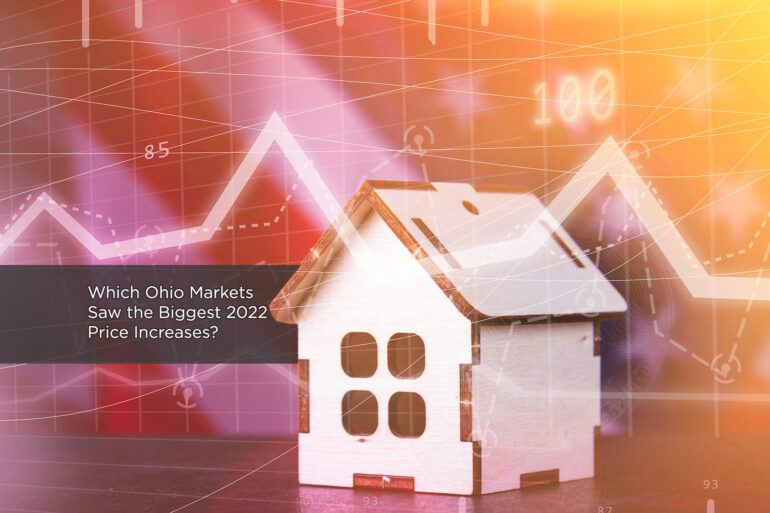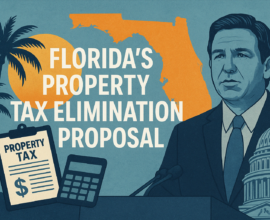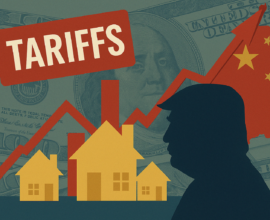Which Ohio Housing Markets had the Biggest Price Increases in 2022?
Overall, many investors in the U.S. real estate market will likely describe 2022 in a single word — volatile. Some of the factors creating volatility include record-high inflation, rising interest rates, and supply-chain challenges that hindered new construction.
In Ohio, housing prices continued to rise statewide in 2022. Through October 2022, the average sales prices in 13 of Ohio’s 14 MLS housing markets rose over the previous 2021 prices. However, the number (volume) of home sales across the 14 markets dipped by roughly 22%.
MLS house sales prices (January through October 2022)
The following chart contains the five housing markets with the largest increase in average sales price:
| Ohio Housing Market (Region) | 2021 Average Sales Price | 2022 Average Sale Prices | Increase % |
| Mansfield | $ 158,229 | $ 176,584 | 11.6 % |
| Columbus | $ 298,730 | $ 332,711 | 11.4 % |
| Knox County (Mt. Vernon) | $ 213,923 | $ 237,768 | 11.1 % |
| Dayton | $ 218,927 | $ 241,763 | 10.4 % |
| Portsmouth (Greater) | $ 137,444 | $ 151,028 | 9.9 % |
Source: MLS Stats
One way that the U.S. Census differentiates small cities from mid to large cities involves excluding sparsely populated communities from their “metropolitan statistical area” reports. They define a metro area as having one urban area with a population of 50,000 or more.
In looking at the chart above in terms of population, only Columbus (900,000+) and Dayton (130,000+) represent mid or large Ohio housing markets. The following chart looks only at the major Ohio housing markets based on the median prices.
As expected, the spike in mortgage interest rates translates to decreased affordability and a less competitive market for available homes.
NAR house sales prices (Third Qtr. 2022)
| Ohio Housing Market (Region) | 2021 Median Sales Prices | 2022 Median Sales Prices | Increase % (vs 2021) |
| Dayton | $ 195,200 | $ 224,200 | 14.9 % |
| Akron | $ 188,700 | $ 215,500 | 14.5 % |
| Columbus | $ 286,300 | $ 312,100 | 9.0 % |
| Cleveland | $ 212,900 | $ 227,000 | 7 % |
| Cincinnati | $ 253,500 | $ 268,400 | 5.9 % |
Source: National Association of Realtors
Among the major Ohio housing markets, Akron, Columbus, and Dayton all experienced significantly higher prices.
During the onset of the pandemic in 2020, the median home values in the state surged with historically low home mortgage rates.
What Factors Are Influencing the Current Market Conditions?
A recent report from Ohio REALTORS cites how the increasing interest rates created a transition in the housing market by lowering activity among many prospective buyers. As expected, the spike in mortgage interest rates translates to decreased affordability and a less competitive market for available homes. In November, the rate on a 30-year fixed mortgage reached approximately 7%, which is more than double the rates from the previous year in the 3% range.
They suggest that this shift in the Ohio housing market is resulting in greater stability and balance — a return to normalcy not seen since the COVID-19 pandemic. Because of the less competitive landscape, the current buyers should recognize more available options in the market.
Amid the increased interest rates, other affordability concerns emerged. For example, this summer saw heightened fuel prices at the pump and food prices remain very high.
As home prices return to more modest levels, some homeowners that recently purchased a home could find themselves underwater.
The Impact of the COVID-19 Pandemic on Home Prices
Looking at the Cleveland, OH market
During the onset of the pandemic in 2020, the median home values in the state surged with historically low home mortgage rates. The result was a “seller’s market” not seen in recent memory.
Cleveland, the largest city in Cuyahoga County, saw approximately a 10% increase in the single-family home market during 2021 alone, which the aforementioned chart indicates continued rising by roughly 7% in 2022.
A representative with the Akron-Cleveland Association of Realtors explained to WKYC, the local NBC affiliate, that much of the spike in prices throughout the Cleveland housing market resulted from a lack of new homes being built. During the pandemic, many residents felt “cramped” in their homes and sought more space as they worked from home, often alongside their children attending school remotely from home.
Meanwhile, the construction of new homes largely stalled, offering no relief for the lack of housing inventory in the community. The price of lumber soared, the disrupted supply chain prevented builders from obtaining materials, and the labor shortage, particularly a lack of truck drivers needed for transporting the few available supplies, further exacerbated the problem.
The Dayton housing market
The Dayton Daily News confirmed that the substantially rising interest rates have slowed home sales in the region from their recent “hyper-active” 2021 levels. However, the selling prices of homes in greater Dayton remain high.
Although the Dayton Realtors’ Multiple Listing Service reported an 11% decrease in sales in October 2022 compared to October 2021, the full, year-to-date decline is only about 5%.
Another interesting factor contributing to fewer home sales is that prospective home sellers are staying put because they also are in no hurry to pay a higher-rate mortgage associated with their next home.
Columbus: the strongest overall Ohio housing market
Among the eight largest metro areas in Ohio, the state capital maintains the highest median home prices at approximately $312,000. While the rise of home prices in most Ohio markets continues cooling, the Columbus housing market remains strong.
A report from the Columbus REALTORS stated that their local market still lacks inventory and population growth keeps fueling demand; therefore, many sellers are still receiving multiple offers from eager, prospective homeowners.
Ohio’s statewide home prices vs the national market
When comparing Ohio’s home prices to the national market, the state’s relative affordability is obvious. With the average median home value in the U.S. at roughly $357,810, Ohio’s median of only $216,746 is about 65% lower.
Aside from the dramatic events in the U.S. economy, pinpointing our current phase within the real estate cycle is difficult based on how the housing supply remains near record lows.
Home Prices Might Leave Some Homeowners “Underwater”
As home prices return to more modest levels, some homeowners that recently purchased a home could find themselves underwater. This is particularly a concern for those who bought a home in the last 18 months. Recent estimates indicate that nearly 250,000 Americans now find themselves with negative equity — meaning they owe more on their home mortgage than the house is currently worth.
Fortunately, the overall underlying U.S. real estate market is considerably stronger than during the 2008 financial crisis and subprime mortgage meltdown. Although the housing supply remains tight, regulators implemented many rules that make a calamity of that magnitude very unlikely.
Further, homeowners today have more equity in their homes than at any point in the last 20 years.
What Phase of the Traditional Real Estate Cycle Are We in?
The real estate cycle or housing market cycle is a traditional model that applies in the realms of residential and commercial real estate, which is composed of four distinct phases: recovery, expansion, hyper-supply, and recession. Most experts agree that the U.S. experienced some very unusual (many unprecedented) economic times since COVID. For example, the “lockdown” phase, the work-from-home “revolution,” and the highest inflation in decades.
Aside from the dramatic events in the U.S. economy, pinpointing our current phase within the real estate cycle is difficult based on how the housing supply remains near record lows. Data from the U.S. Department of Housing and Urban Development suggested that construction of new single-family homes and applications for building permits remained low through October.
Projections / Outlook for Ohio Housing Prices
How will home prices fair in Ohio’s largest housing markets in 2023?
The Realtor.com Housing Forecast predicts that prices will rise by roughly 5% nationwide in 2023; however, sales volume might largely depend on what the Fed has in store for interest rates. Here in Ohio, it seems that the limited supply should translate to rather stable home prices. Keep in mind that the supply chain problems that limited access to building materials may continue improving, which could jumpstart new home construction projects and boost inventory.








